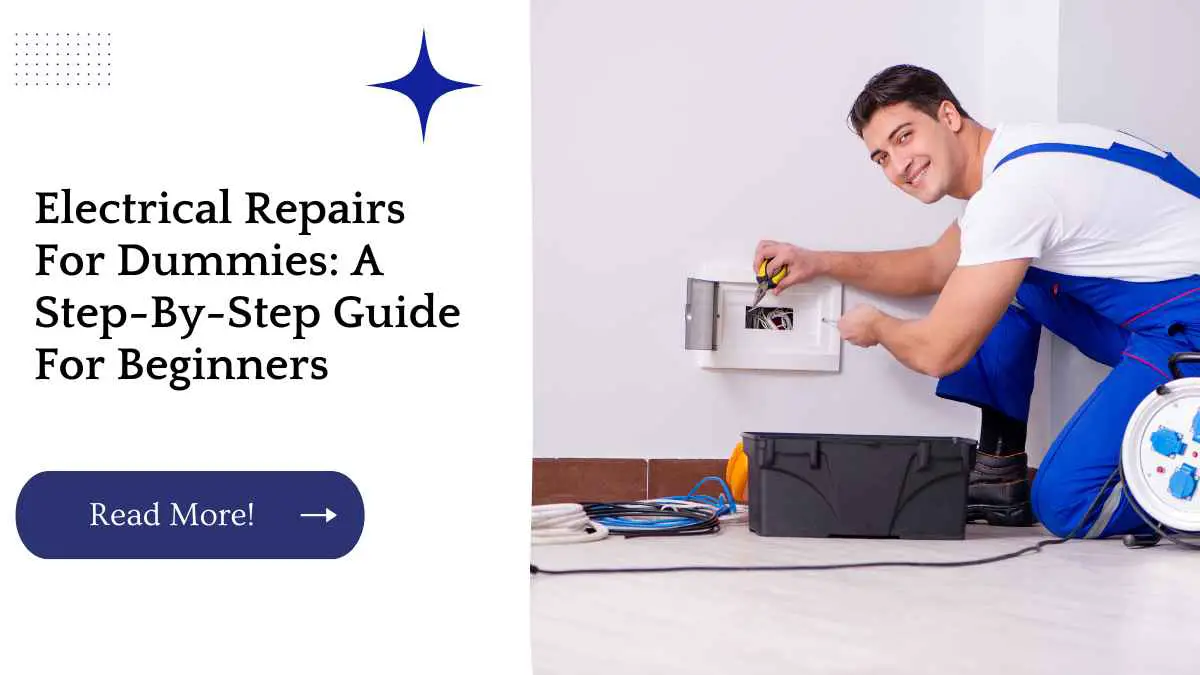When you need to make electrical repairs, it can be confusing and intimidating. If you’ve never done electrical work before, it might seem like there are hundreds of things that could go wrong or that can’t possibly be right!
The good news is that all electrical repair jobs are pretty similar. You’ll always start by turning off the breaker or fuse that powers the circuit you’re working on—and then test it to see how many items aren’t working properly within the circuit.
From there, you’ll need to diagnose where exactly in your home’s wiring system the problem started so you know what needs to be replaced or repaired before everything works perfectly again!
| Takeaways |
|---|
| 1. This guide provides a step-by-step approach to electrical repairs for beginners. |
| 2. It offers comprehensive explanations and instructions for various electrical repair tasks. |
| 3. Safety precautions and best practices are emphasized throughout the guide. |
| 4. The guide helps beginners gain confidence in handling basic electrical repairs. |
| 5. It serves as a valuable resource for understanding electrical systems and troubleshooting common issues. |
1. Inspect The Electrical Problem
You should always start by inspecting the electrical problem in order to determine its cause and severity, as well as what tools you’ll need to repair it. If you don’t know what you’re dealing with, it’s difficult to fix anything!
2. Power Off The Circuit
The first thing you need to do is turn off the power to the circuit. This can be done by turning off the circuit breaker or flipping it up with your hand.
You should also check if there are any loose wires, as those could pose a fire hazard if left unattended. If there are no loose wires and all of your equipment is plugged in correctly, then it’s time for step 3!
| Component | Brands |
|---|---|
| Computers | Dell, HP, Lenovo, Apple, Microsoft |
| Appliances | Samsung, LG, Whirlpool, Bosch, GE |
| Lighting Fixtures | Philips, Cree, Osram, GE, Lutron |
| Audio/Video Equipment | Sony, Samsung, LG, Bose, Panasonic |
| Industrial Machinery | Siemens, ABB, Schneider Electric, Rockwell Automation |
| HVAC Systems | Carrier, Trane, Daikin, Lennox, Rheem |
3. Check For Loose Wires And Connectors
Check for loose wires and connectors. If a wire is loose or disconnected, it will cause a short circuit when you turn on the power to your microwave oven.
You can check this by unplugging your appliance, then taking off its cover and inspecting each part of it carefully while it’s still unplugged (and before touching anything!).
Look at all of the connections between metal parts, as well as between plastic parts and metal ones–and don’t forget those little screws!
Plumbing emergencies can occur unexpectedly, causing stress and potential damage. Be prepared and learn how to handle the most common plumbing emergencies with our step-by-step guide, ensuring you’re equipped to tackle any unexpected situations.
4. Test Your Multimeter To Make Sure It’s Working Properly
Once you have your multimeter and know how to use it, it’s time to test it. To do this, you’ll need a known voltage source.
A battery will work just fine for this purpose; just make sure the battery isn’t discharged or dead before testing with it.
You can also use another piece of equipment that has a known resistance (such as an incandescent light bulb), current (like an ammeter), and voltage drop across it (for example: if there is 1 ohm of resistance on one wire and no other resistances in series).
5. Check For Open Circuits
When you’re testing for a short circuit, you want to look for a closed loop that interrupts the flow of electricity.
Open circuits are just the opposite: they allow current to pass through without interruption. In an open circuit, there’s no connection between two points in your wiring system–the wire isn’t touching anything at all (or it’s touching something that doesn’t conduct electricity).
You can test whether or not your wires are connected by using either a continuity tester or an ohmmeter (see below).
If neither device detects any continuity between two points on your circuit breaker panel, then there’s probably an open circuit somewhere in it–probably because one of those screws came loose!
Ensuring the safety of your home doesn’t have to break the bank. Discover the top 10 home security fixes that fit every budget and provide peace of mind for you and your family.
6. Test Individual Components Of The Circuit
Now that you’ve identified the problem, it’s time to test each individual component of the circuit. First, test one component at a time and then move onto testing all components connected to your circuit.
Test each individual component by disconnecting it from its respective connections in order to isolate any faults within that particular piece of equipment or wiring.
If a wire is loose or broken, this should become apparent when you attempt to remove it from its respective terminals on an outlet or switchplate cover plate (if applicable).
Also note that with older homes where wiring may be faulty or outdated due to wear-and-tear over time as well as age, some types of damage may not show up until after removal has taken place due to deterioration over years’ worth of use–so always check carefully before pulling anything apart!
| Component | Brands |
|---|---|
| Resistors | Ohmite, Vishay, Panasonic |
| Capacitors | KEMET, Nichicon, Panasonic |
| Diodes | ON Semiconductor, NXP, Vishay |
| Transistors | Texas Instruments, STMicroelectronics |
| Integrated Circuits | Texas Instruments, Analog Devices, NXP |
| Relays | Omron, TE Connectivity, Panasonic |
7. Repair And Replace Damaged Cables And Wires
When you’re repairing electrical problems in your home, it’s important to know how to repair damaged cables and wires. Here are some tips:
Repairing a damaged cable or wire is a lot like mending a broken shoelace. The first thing you have to do is cut off the damaged portion of the wire with wire cutters (or scissors), leaving as much length as possible on both sides of where it broke off.
Then strip off about 1/2 inch of insulation using a stripper tool (if necessary), exposing bare copper underneath.
Next, twist together all three exposed ends of copper–this helps prevent future shorts from happening in that area by creating one continuous path through which electricity can flow smoothly without interruption from bumps along its route.
Dealing with common plumbing issues can be a hassle, but knowing how to fix them can save you time and money. Learn about the top 15 most common plumbing issues and get expert tips on how to resolve them effectively.
8. Replace Damaged Components With New Ones From Your Parts Bin
If you can’t find the problem, and your circuit breaker or fuse keeps tripping, it’s time to replace the damaged component with a new one from your parts bin.
You’ll need to test the fuse or breaker first using a multimeter so that you know which size replacement part is needed (and make sure this fits in your panel).
Next, remove the old component by unscrewing its mounting screws; then install its replacement by screwing it back into place with those same screws.
| Component | Brands |
|---|---|
| Resistors | Ohmite, Vishay, Panasonic |
| Capacitors | KEMET, Nichicon, Panasonic |
| Diodes | ON Semiconductor, NXP, Vishay |
| Transistors | Texas Instruments, STMicroelectronics |
| Integrated Circuits | Texas Instruments, Analog Devices, NXP |
| Relays | Omron, TE Connectivity, Panasonic |
| Connectors | Molex, TE Connectivity, Amphenol |
| Switches | Omron, E-Switch, C&K Components |
| Fuses | Littelfuse, Bussmann, Eaton |
9. Replace A Blown Fuse Or Breaker With New Ones From Your Parts Bin
When you have a blown fuse, it’s time to replace it with a new one. The first thing you need to do is find out what kind of fuse or breaker you need by looking at the label on your old one.
Then go through your parts bin and find the right replacement part for that circuit in your home or office building.
You’ll want to keep in mind that there are different types of fuses depending on how much electricity they can safely handle before blowing:
- A 1/4-inch cutlery fuses at 15 amperes (A)
- A 1/2-inch knife blade (KBK) fuses at 20 A
Proper HVAC maintenance is essential for a comfortable home environment. Become a proactive homeowner with our comprehensive ultimate guide to HVAC maintenance, where you’ll find valuable tips and insights to keep your HVAC system running smoothly.
Conclusion
We hope that this guide has helped you understand how to repair your own electrical problems. If you’re unsure of what to do next, we encourage you to try out some of these tips on your own home or office.
You can start small by testing a circuit before turning it back on again, or even checking for loose connectors in outlets or switches!
Further Reading
Here are some additional resources that can provide further information and insights on electrical repairs and related topics:
Electrical Basics: A Beginner’s Guide: This comprehensive guide covers the fundamental concepts of electrical systems, offering beginners a solid foundation to understand electrical repairs and maintenance.
How to Fix Everything For Dummies: This book is a valuable resource for beginners, providing step-by-step instructions and guidance on fixing various household issues, including electrical repairs.
Electricity for Dummies: This blog post explains the basics of electricity in an easy-to-understand manner, making it an ideal resource for beginners seeking a simplified introduction to electrical concepts.
FAQs
Here are some frequently asked questions related to electrical repairs and their corresponding answers:
How can I safely perform basic electrical repairs at home?
When performing basic electrical repairs, it’s crucial to ensure your safety. Always turn off the power, use insulated tools, and follow proper wiring practices. If you’re unsure, it’s best to consult a licensed electrician.
What are the common signs of electrical problems in a home?
Common signs of electrical problems include flickering lights, frequently tripped circuit breakers, outlets or switches that feel warm, burning odors, or sparking outlets. If you notice any of these signs, it’s important to address the issue promptly.
Can I replace a damaged electrical outlet myself?
While replacing an electrical outlet may seem straightforward, it requires knowledge of electrical wiring. If you’re confident in your abilities and follow safety precautions, you can replace a damaged outlet. Otherwise, it’s recommended to consult a professional electrician.
How often should I have my electrical system inspected?
It’s advisable to have your electrical system inspected by a qualified electrician every 5 to 10 years, or sooner if you experience recurring electrical issues or if your home is older.
What should I do if I experience an electrical emergency?
In the event of an electrical emergency, such as an electrical fire or severe electrical shock, prioritize your safety by immediately leaving the area and calling emergency services. Do not attempt to handle the situation yourself.

Hello, everyone! My name is Hellen James and I’m the founder of Unified Fix. I’ve been a home improvement enthusiast for years, so when we started this blog, I knew that it was important to me that we shared our knowledge with you.

